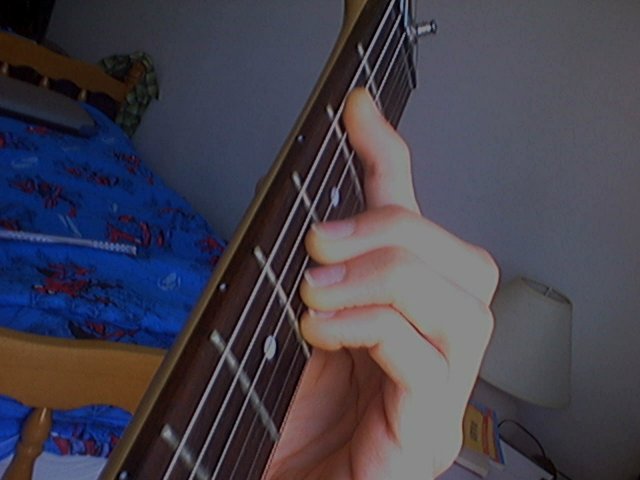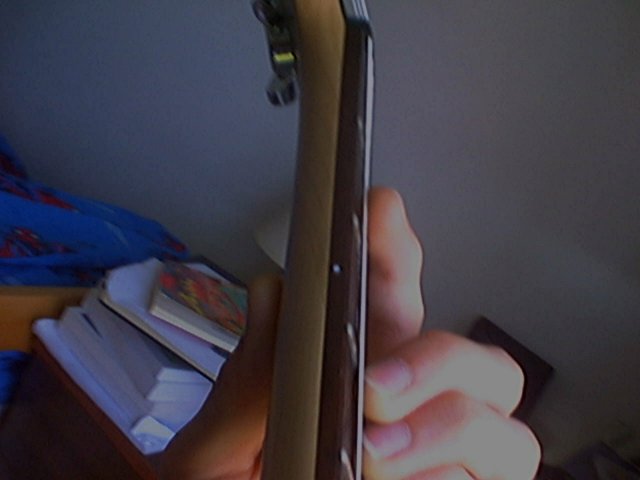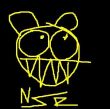| btimm |
|
24 May 2010 07:54 | Quote |
Joined: 14 Dec 2009 United States  Lessons: 2 Licks: 1 Karma: 16 
|
I have a question about barre chords. I am seeing significant improvements in the following form of barre chords, using F for an example:
133211
But to play a B barre chord for example in this form:
x24442
I struggled to not mute the high e string. Is there some tips anyone could provide to not mute that string? I am playing it with my ring finger barring the 4th string. Is this incorrect technique? I have large hands, but I imagine people overcome this all the time. :o) Thanks for any advice or drills or anything. |
| Phip |
|
24 May 2010 08:40 | Quote |
Joined: 23 Dec 2007 United States  Lessons: 1 Karma: 45  Moderator Moderator
|
Hey btimm,
First, it's not the end of the world that you are muting the F# on the 1st sting since you are creating it on the D string. But try this, keep an eye on your thumb placement when making this chord. Try keeping your thumb lower on the back of the neck. This may help. Meanwhile keep working on that crazy bend of your ring finger. you'll get it eventually.
hth
Phip |
| btimm |
|
24 May 2010 08:58 | Quote |
Joined: 14 Dec 2009 United States  Lessons: 2 Licks: 1 Karma: 16 
|
Yeah, it didn't sound bad or anything played this way, I just wanna try my best to get it right. I'll definitely keep an eye on that thumb positioning and keep working at it! Thanks for the good advice. |
| Guitarslinger124 |
|
24 May 2010 14:23 | Quote |
Joined: 25 Jul 2007 United States  Lessons: 12 Licks: 42 Karma: 38  Moderator Moderator
|
Try playing your chord like so:
e:-2-|
B:-4-|
G:-x-|
D:-4-|
A:-2-|
E:-2-|
I know right away that looks harder than what you are doing, but I think it is a much easier way to play B Major in that position.
Or, if you are playing with someone else, or you are recording more than one guitar, play it like this:
e:-x
|
| Guitarslinger124 |
|
24 May 2010 14:25 | Quote |
Joined: 25 Jul 2007 United States  Lessons: 12 Licks: 42 Karma: 38  Moderator Moderator
|
Hmm... I don't know what happened to the rest of my post, but that last chord was:
e:x
B:4
G:x
D:4
A:2
E:x
Mute the "x"'s with your index finger.
Rock on! |
| Ozzfan486 |
|
24 May 2010 14:57 | Quote |
Joined: 01 Oct 2008 United States  Licks: 1 Karma: 18 
|
B can also be played on the 7th fret in the same formation you used for that F on the 1st btw. |
| Mici |
|
24 May 2010 15:04 | Quote |
Joined: way back Kosovo  Karma Karma: 9 
|
Why not mute the E string? I mean, I've done a lot of practice until I finally learnt to mute the E string when playing barre chords with the root note on the A string. |
| btimm |
|
24 May 2010 21:19 | Quote |
Joined: 14 Dec 2009 United States  Lessons: 2 Licks: 1 Karma: 16 
|
Mici, based on the post from Phip, I am not sure it is a bad thing to mute the e string, but if I can learn to do it properly, I'd sure like to do so. Large fingers have their problems though ... lol |
| Mici |
|
25 May 2010 05:07 | Quote |
Joined: way back Kosovo  Karma Karma: 9 
|
Hahah! I had difficulty muting it but with time I learnt to just touch it with the tip of my index finger from below. I just two pictures of that. I hope it's visible enough to you.
The reason why I mute the e string in chords like the B, is that I want B to the lowest note I am playing since that is the root note of the B chord (major, minor, whatever). If I am correct, if I wouldn't mute it it would be a B/F#. |
| Mici |
|
25 May 2010 05:10 | Quote |
Joined: way back Kosovo  Karma Karma: 9 
|
Here's the pictures.

 |
| gx1327 |
|
26 May 2010 12:24 | Quote |
Joined: 20 Sep 2009 United States  Karma Karma: 9 
|
Phip says: First, it's not the end of the world that you are muting the F# on the 1st sting since you are creating it on the D string.
yes but wouldn't playing that F# on the low e string make the chord "F#/B"? theoretically, the chord should start with its root note (hence playing (low to high) 224442 contains all the notes in the B Major chord, but you are starting on the F#. playing x24442 contains all the same notes, but starts on the B)
just do what mici says. don't mute it by pressing ON (top) of the string, mute it by sliding the tip of your index finger up against the low E. this way the entire force of your index finger is pressing down, but the low E is resting against the pointing tip of your index finger. it's fairly easy to mute the E string that way, for 5-string majors (x24442) and 5-string minors (x24432), as well as any other barre chord that mutes the low E.
one method of practice --- forget the ring finger. just try strumming x22222 and pay attention to which strings are ringing and which are muted. after you are comfortable with that, add the ring finger (yes that's the easiest way to play it) to make the major barre chord.
Ozzfan486 says: B can also be played on the 7th fret in the same formation you used for that F on the 1st btw.
true but i don't think anyone will argue that it's not useful to learn the 5th string barre chords. some of them have a different voicing (depending which way on the fretboard you move) than the 6 string counterparts. plus it can help to limit movement up and down the fretboard. for instance if you wanted to play the proression Am Dm, E, Dm would it make more sense to play:
5.7.7.5.5.5
10.12.12.10.10.10
0.2.2.1.0.0
or
577555
x57765
x79997
oh also being able to mute the low E string is helpful (and mandatory) when playing power chords on the 2nd string instead of the 1st. |
| btimm |
|
26 May 2010 12:59 | Quote |
Joined: 14 Dec 2009 United States  Lessons: 2 Licks: 1 Karma: 16 
|
I think I have been misunderstood. In that barre chord form of x24442, I have no problem whatsoever in muting the string that should be muted. My problem is my fingers don't cooperate and mute the high e string, so I instead end up playing x2444x. |
| gx1327 |
|
26 May 2010 16:02 | Quote |
Joined: 20 Sep 2009 United States  Karma Karma: 9 
|
oh. yeah completely different problem. i just think you have to work on finger strength to be able to smash down all those strings with your index finger. when you first start you can make that barre shape with the index finger but if you make the chord and pluck each string a lot of times they dont' ring true. but i've noticed in my own playing that as the weeks go by it becomes easier and more natural that when you make that barre you will effectively fret each string.
my problem is more with the middle strings, someimtes they land in the gap created by each knuckle along the finger, instead of landing on a flat fleshy part of my finger... |
| btimm |
|
26 May 2010 16:18 | Quote |
Joined: 14 Dec 2009 United States  Lessons: 2 Licks: 1 Karma: 16 
|
It's not the index finger whatsoever, hence why I have no problems playing a chord like an F barre chord of 133211. It is the ring finger that plays the 444 portion of x24442 - it mutes the e string. |
| Admiral |
|
27 May 2010 14:58 | Quote |
Joined: 10 May 2009 Germany  Lessons: 1 Karma: 12 
|
well, i play it like mici, with my index finger on the 2 and the rest of my fingers on 1 fret per finger. do you do another barre with your ring finger or do you play it like mici and me? I have never heard about the case that someone actually can't do it, so you would be the first (which i don't believe) Have you tried stretching before playing guitar? and maybe do some warm up runs, this may improve your dexterity and help you not to mute the string? |
| merlloydlim |
|
14 Jun 2012 12:13 | Quote |
|
Hi btimm, wondering if you're still experiencing this problem with the muting of the high e string from your ring finger. Having the same problem.. Would be extremely grateful if you reply. Cheers! |
| btimm |
|
19 Jun 2012 09:14 | Quote |
Joined: 14 Dec 2009 United States  Lessons: 2 Licks: 1 Karma: 16 
|
Sorry for the delay merlloydlim, I don't come on this site as often as I used to. Anyways, I have been fairly strapped for time as far as practicing goes, so I never stuck with trying to learn to use my three fingers to play the appropriate notes in this chord form, so I continue to just barre it using my ring and index fingers. Over time, I plan to train my large fingers to stop muting the high e string, because that would allow me to alter the chord sufficiently by changing where my middle, ring, and pinky are. You obviously cannot do this if you using your ring finger to barre those three notes. It is what it is for now. |
|
|












